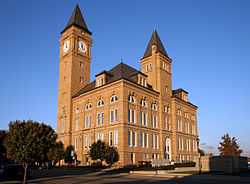Tipton County Courthouse
|
Tipton County Courthouse | |
 | |
|
Tipton County Courthouse in Tipton, Indiana | |
 | |
| Location | Public Sq., Tipton, Indiana |
|---|---|
| Coordinates | 40°16′54″N 86°3′9″W / 40.28167°N 86.05250°WCoordinates: 40°16′54″N 86°3′9″W / 40.28167°N 86.05250°W |
| Area | 2 acres (0.81 ha) |
| Built | 1893 |
| Architect | Adolph Scherrer; Pearce & Morgan (builder) |
| Architectural style | Romanesque Revival architecture |
| Governing body | Local |
| NRHP Reference # | 84001665[1] |
| Added to NRHP | March 1, 1984 |
The Tipton County Courthouse is located in Tipton, Indiana. The courthouse is Tipton's third and was completed in 1894.[2] It was added to the Historic Register of Historic Places on March 1, 1984.
The courthouse is an example of Romanesque Revival architecture and was designed by Adolph Scherrer who also designed the 1888 Indiana State Capitol.[2]
Sherrer took over the architectural design work for the Indiana Statehouse project from Edwin May who died in 1880. Five years after the completion of the capitol building project in 1888, Scherrer began work on the Tipton County Courthouse building.[3]
It is built of sandstone in a Romanesque architecture style with a clock tower that rises 206 feet above the ground. It is topped by a flagstaff. The building was constructed by Pierce and Morgan of Indianapolis during 1893 and 1894 at a cost of $170,988.[n 1] It is one of several Romanesque courthouses dating from the 1890s that are still in use.[4]
See also
Notes
References
- ↑ "National Register Information System". National Register of Historic Places. National Park Service. 2010-07-09.
- ↑ 2.0 2.1 Plaque in front of courthouse
- ↑ 3.0 3.1 Williamson, Samuel H. (April 2010). Seven Ways to Compute the Relative Value of a U.S. Dollar Amount, 1774 to present. MeasuringWorth. Calculations made using Nominal GDP Per Capita, a measure of capital intensivity, using "the 'average' per-person output of the economy in the prices of the current year." This is a measure of the amount of capital and volume of labor required to reproduce the work over varying production methods, but assuming that money represents a proportion of the economy.
- ↑ Counts, Will; Dilts, Jon (1991). The 92 Magnificent Indiana Courthouses. Bloomington, Indiana: Indiana University Press. pp. 166–7. ISBN 978-0-253-33638-5.
| ||||||||||||||||||||||||||